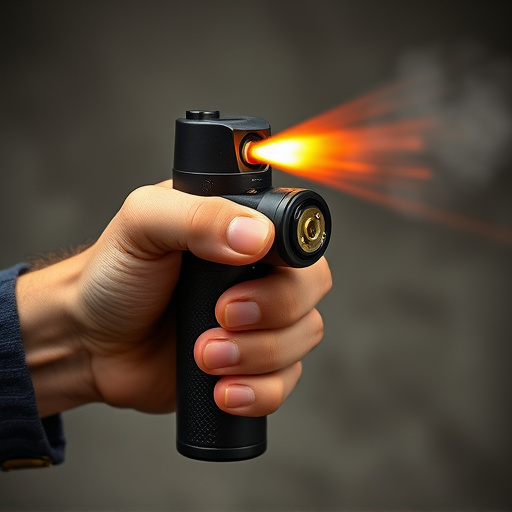TL;DR:
Exposure to pepper spray requires immediate home decontamination involving moving to a safe, well-ventilated area, removing contaminated clothing, and washing eyes, skin, and hair with generous amounts of water for 15 minutes. This process prevents severe symptoms or long-term health issues. Proper steps include ventilating the area, disposing of contaminated items, wiping down hard surfaces, and rinsing thoroughly. Effective decontamination is crucial after encounters with pepper spray, especially considering its widespread use by law enforcement, to ensure safety and mitigate effects.
Riot control agents, a powerful tool in law enforcement, have revolutionized how police manage public order. From pepper spray to other chemical agents, understanding their types and effects is crucial for both officers and civilians. This article explores common riot control agents, focusing on pepper spray, its decontamination steps at home, and the legal considerations surrounding its use. We also delve into safety protocols, ensuring a balanced approach to maintaining public safety.
- Understanding Riot Control Agents: Types and Effects
- Pepper Spray: A Common Tool in Law Enforcement
- Home Decontamination After Exposure to Riot Control Agents
- Legal Considerations and Safety Protocols for Law Enforcement Use
Understanding Riot Control Agents: Types and Effects
Riot control agents, also known as crowd-control measures, are chemical substances deployed by law enforcement and military personnel to subdue or disperse rioters and protesters. These agents come in various forms, each with unique effects on the human body. One of the most common types is pepper spray, which uses capsaicin to cause temporary blindness, coughing, and pain.
When exposed to riot control agents like pepper spray, decontamination steps at home are crucial. After coming into contact with these substances, individuals should immediately seek a safe, well-ventilated area. Removing contaminated clothing and washing eyes, skin, and hair with large amounts of water for at least 15 minutes is essential. Pepper spray decontamination involves thorough rinsing to ensure no residual chemicals remain on the body, preventing further irritation or potential long-term health effects.
Pepper Spray: A Common Tool in Law Enforcement
Pepper spray, a common tool in law enforcement, is a powerful riot control agent designed to incapacitate individuals temporarily through irritation and pain. Its use has become widespread globally due to its effectiveness in de-escalating potentially dangerous situations. In many cases, law enforcement officers employ pepper spray as a last resort when other non-lethal methods prove unsuccessful.
Despite its prevalence, it’s crucial for the public to understand the decontamination steps after exposure to pepper spray. Following an encounter, individuals should immediately seek fresh air and wash their faces, eyes, and skin with soap and water. These simple measures help alleviate symptoms and prevent prolonged discomfort. Additionally, keeping a nearby shower or eyewash station can aid in swift decontamination, especially at home, making it an essential knowledge point for anyone potentially exposed to pepper spray, including those who live in areas where law enforcement use it regularly.
Home Decontamination After Exposure to Riot Control Agents
After being exposed to riot control agents like pepper spray during a confrontation, decontaminating your home is crucial to ensure safety and prevent lingering effects. Start by opening all windows and doors to ventilate the area thoroughly. This step helps dissipate the chemical residues in the air. Next, gather any contaminated clothing, shoes, or personal items and place them outside in a plastic bag for safe disposal later.
For decontaminating surfaces, use water mixed with mild detergent or a specialized cleaning solution designed to break down pepper spray chemicals. Wipe down all hard surfaces, including furniture, floors, and walls. Pay special attention to areas where the spray may have settled, such as corners, crevices, and under objects. After cleaning, thoroughly rinse all cleaning materials used in the process to avoid any potential cross-contamination.
Legal Considerations and Safety Protocols for Law Enforcement Use
Law enforcement agencies must adhere to stringent legal considerations and safety protocols when employing riot control agents, such as pepper spray, in their operations. The use of these substances is regulated by a complex web of federal, state, and local laws, ensuring that officers act within legal boundaries. These regulations dictate the circumstances under which law enforcement can deploy such agents, focusing on proportionality and necessity to ensure public safety without excessive force.
After any confrontation involving riot control agents, proper decontamination steps at home are crucial. This includes immediate removal of contaminated clothing and footwear, thorough washing of the skin with soap and water, and ensuring that all affected areas are rinsed extensively. Pepper spray decontamination involves specific techniques to mitigate its effects, emphasizing the importance of training for law enforcement officers and individuals who may come into contact with these substances.
Riot control agents, such as pepper spray, play a significant role in law enforcement, but their use comes with important legal and safety considerations. Understanding the types of agents, their effects, and the decontamination steps, like those for home decontaminating after exposure to riot control agents, is crucial for both officers and civilians. Adhering to safety protocols and legal guidelines ensures that these tools are effectively and responsibly employed, fostering a safer environment for all. To minimize risks, it’s essential to follow established procedures for both the use of pepper spray and subsequent decontamination, particularly within residential settings.
